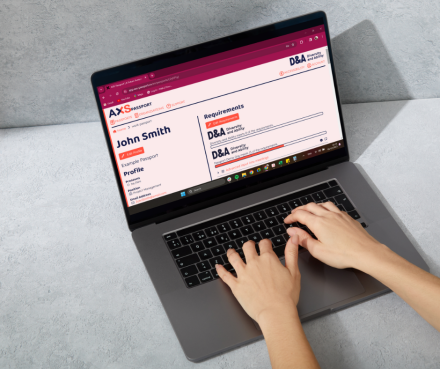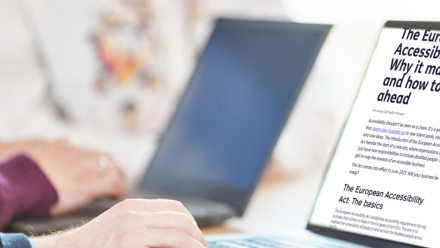Do adjustments passports work for both workplaces and disabled employees?
12th January 2025 by Scarlett James

Adjustment passports are often touted as a solution for creating the ultimate inclusive workplace; can they really live up to their promise?
In the past few years, adjustment and inclusion passports have hit the big time. We know- we created one, and it won awards! And we weren’t alone; organisations of all shapes and sizes have begun investing in passports. But getting passports right isn’t always easy.
Expert insights from d&i Leaders and the Business Disability Forum have highlighted what many Disabled people already knew about adjustment passports. They’re not an instant fix; in fact, they often end up being nothing more than a box-ticking exercise and- at their worst- create more workplace barriers. Our disabled team designed the AXS Passport to overcome the challenges often associated with adjustment passports and ensure they genuinely work for Disabled people.
What’s the problem with passports?
The idea of passports is simple: a documented, structured way for employees to share their workplace needs and for organisations to respond clearly and consistently. But, in practice, issues can arise. It could be a lack of manager guidance, unclear (or unsafe) data practices, inflexible documents or practices, or adding extra pressure for Disabled employees to disclose and self-advocate. Despite these risks, we saw the value in having a method by which to start difficult conversations both for individuals facing barriers and for the person seeking to remove those barriers for someone else.
How does AXS Passport get it right? And what can you do to get it right too?
-
Guidance and training for managers
Passports are only as effective as the people implementing them. That’s why AXS Passport comes as part of a package with our world-class group training. With organisation-wide training on the social model of disability and the benefits of reducing workplace barriers, you’ll have managers who aren’t just equipped to support their teams; they’re motivated to do it. Provide your managers with clear guidance on how to use your passport alongside your adjustments process. Otherwise, they’ll either avoid promoting them out of fear of getting it wrong, or you’ll find that adjustments are being implemented inconsistently across teams.
-
Let employees stay in control of their data
Traditionally, for Disabled employees, adjustment passports meant writing up every detail of your medical history and health for the millionth time, sending it off to a company email address, and never knowing where that data would end up, let alone if anything would come from it. AXS Passport enables individuals to maintain control of their information, ensuring that employees can own their own data and decide who accesses it. By not forcing employees to relinquish control of their information, you’re building trust and fostering psychological safety.
3. Make the process accessible to all
Adjustment passports should reduce barriers, not create more. Make your passports accessible to everyone because there’s no benefit to gatekeeping adjustments. In fact, everyone benefits from being able to access adjustments. Check out the seven adjustments everyone loves.
Don’t ‘other’ your Disabled employees by implying they’re the only ones with inclusion needs. Your passport should be set up for an adjustments process that supports the nine protected characteristics and beyond:
- A parent juggling work and school runs might benefit from flexible hours
- A religious employee might need a private prayer space
- An employee experiencing menopause might need temperature and comfort adjustments to feel comfortable at their desk
By making passports available to everyone, organisations reduce stigma and create a shared culture of belonging.
4. Keep conversations going
A passport should be the start of a conversation, not the end of one. Adjustments and needs both evolve over time, so make sure your system is agile and flexible. Enable your employees to adjust their passports with ease so they can efficiently and confidently inform you of any temporary or longer-term changes. Regularly review adjustments requested and provided to confirm you’re successfully meeting the needs of your employees.
5. Use the data to drive change
Adjustment passports offer a unique opportunity to collect anonymised data about the barriers within your workplace. Gaining access to adjustment data takes the element of surprise out of workplace inclusion, giving you insight into trends in adjustment requests that you can use to guide budgeting, planning and policy updates. Proactively addressing easy wins can have a monumental impact on cost and efficiency; if half of your organisation is requesting meeting agendas in advance, implementing this as a standard practice doesn’t just make meetings more productive; it saves hours of time and effort in individual adjustments meetings.
The key to success for passports
Adjustment passports are one piece of the inclusion puzzle. To truly work, they must be considered alongside:
- A culture of celebrating diversity and championing inclusion
- Normalised conversations about workplace barriers, needs and preferences
- A robust process of implementing adjustments and regularly reflecting on their impact
How can you get started?
If you’re considering implementing an adjustment passport, take advantage of the free tools that are available to help.
AXS passport is available as a free resource to support your employees in sharing their needs and your line managers in knowing what to do next. It’s a practical starting point for organisations looking to embed meaningful change.
Create your free AXS Passport and start having the conversations that matter.


